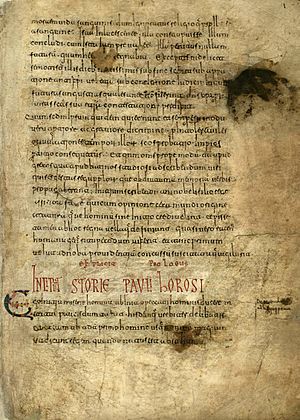Códice de Roda facts for kids
The Códice de Roda (say: KOH-dee-thay day ROH-dah) is a very old handwritten book. It's also called the Códice de Meyá. This special book is from the Middle Ages, a long time ago. It tells us a lot about the Kingdom of Navarre and nearby areas in the 800s and early 900s. Today, you can find it in Madrid, Spain, at the Royal Academy of History.
This ancient book, called a codex, was probably made in the late 900s. Some parts were added later, in the 1000s. It was put together in Navarre, maybe in a town called Nájera. The writing style is called Visigothic minuscule, which is a type of old handwriting. Different people wrote parts of it. The book is about 205 mm × 285 mm (8.1 in × 11.2 in) in size and has 232 pages, called folios.
The Códice de Roda was kept in Nájera in the 1100s. Later, by the late 1600s, it was in the cathedral archives in Roda de Isábena. In the 1700s, a church leader from Santa María de Meyá bought it. After that, it went into private hands. For a long time, scholars could only study copies of it. The original book was finally found again in 1928.
Contents
What's Inside the Códice de Roda?
This old book has many different writings. Some are copies of famous texts from ancient times and the Middle Ages. For example, the first two-thirds of the book is a copy of a work by Paulus Orosius called Seven Books of History Against the Pagans.
Other important texts include:
- Isidore of Seville's History of the Goths, Vandals and Suebi.
- The Chronica prophetica (a book of prophecies).
- The Historia de Melchisedech and the Storia de Mahometh.
- A book called Tultusceptru de libro domni Metobii.
- A genealogy of Jesus, which is like a family tree of Jesus.
The Códice de Roda also has some very special parts that you can't find anywhere else. These unique sections include:
- Lists of Arab rulers.
- Lists of Christian kings from Asturias, León, Navarre, and France.
- A history of the Kingdom of Navarre.
- The Chronicle of Alfonso III.
- A list of important dates for the bishops of Pamplona.
- A letter called De laude Pampilone epistola.
- It even has a special song, called a chant, for a queen of Navarre named Leodegundia Ordóñez. We don't know much about her from other sources.
Family Trees of Kings and Queens
The Códice de Roda is most famous for its family trees. These genealogies show the family lines of important rulers on both sides of the Pyrenees mountains. The Pyrenees separate Spain and France. These family trees are super important because they help historians understand the few other records we have from that time.
The family accounts in the codex go back as many as five generations. They usually end in the first half of the 900s. These family trees include the rulers of Pamplona, such as the Íñiguez and Jiménez families. They also cover the counts of Aragon, Sobrarbe, Ribagorza, Pallars, Toulouse, and the dukes of Gascony.
Some historians think these family trees might have been created in a Muslim area of Spain, called Al-Andalus, in the Ebro valley. They believe these records then made their way to Navarre when the codex was put together.
Images for kids
See also
 In Spanish: Códice de Roda para niños
In Spanish: Códice de Roda para niños




